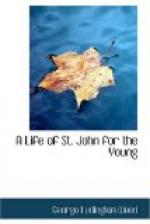We long to know whether “Jesus as He walked” came near the Baptist, and with what salutation they met, and what were their parting words, for this seems to be the last time of their meeting. If Mary and Salome were sisters, and Elizabeth was their cousin—as we use the term—John of Galilee and Jesus were related to John the Baptist in the same way. But there was a closer relationship than that of family. In this Jesus was the connecting link between the two Johns. “One on each side of Christ”—this was their joy and their glory. One was the last prophet to proclaim His coming: the other was to be the last evangelist to tell the story of His life on the earth.
When the Baptist the second time uttered the cry, “Behold the Lamb of God!” “the two disciples heard Him speak and followed Jesus.” Their old master saw them turn from him without a jealous, but with a gladsome thought. Encouraged by him, and drawn by Jesus, with reverential awe, in solemn silence or with subdued tone, they timidly walked in the footsteps of the newly revealed Master. The quickened ear before them detected their footsteps or conversation. “Jesus turned and saw them following,” as if to welcome their approach, and give them courage. He then asked them a question, “What seek ye?” It was not asked because He was ignorant, but to encourage them in familiar conversation, as He did at other times. Their answer was another question, “Rabbi, where abidest Thou?” They longed for a fuller opportunity than that on the road to be taught by Him. “Come and see,” was His welcome reply. “They came and saw where He dwelt, and abode with Him that day.” First by a look, then a question, then an invitation, then hospitality, they were drawn to Him, and into His service.
[Illustration: TRADITIONAL PLACE OF CHRIST’S BAPTISM From Photograph Page 63]
Often in after years must Andrew and John have recalled that walk with Jesus, and “rehearsed the things that happened,” and said one to another, “Was not our heart burning within us while He spake to us in the way?” So afterward did other two, of Emmaus, when “Jesus Himself drew near and went with them.” But the eyes of Andrew and John were not “holden that they should not know Him.” The pleasing dream of years was past: they were wakening to a glorious reality. Their following of Him in that hour has been claimed to be “the beginning of the Christian Church.”
That day of abiding with Jesus was the first of many days these disciples spent with Him, knowing Him more and more perfectly, and the truth which He alone could reveal. They were then passing from the school of the Baptist to that of the Greatest Teacher. What was said in those sacred hours? John has reported other private interviews with Jesus, but concerning this one his lips are sealed. Did he tell of his surprise and joy to learn that He, Jesus, the son of his aunt, Mary, was the Messiah of whom his mother, Salome, had taught him from his early days? Were there any memories of childhood—of the sandy beach of Bethsaida, or the hills of Nazareth; or, were all such thoughts buried in newer and deeper question? Was there any hint of their future relation too sacred for others then to know? Was this the beginning of that sweet intimacy so private then, but of which the whole world should hear in all coming time?




